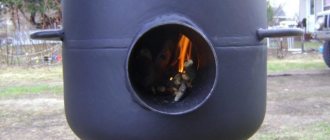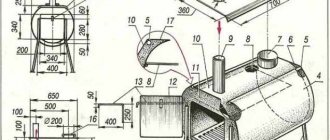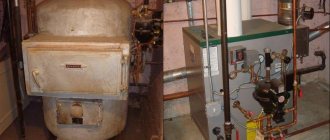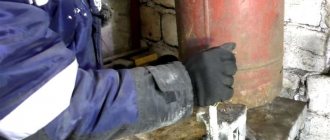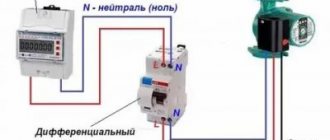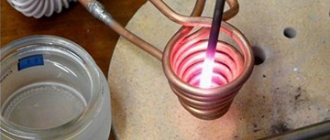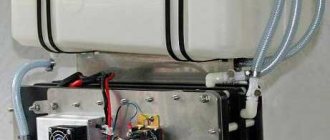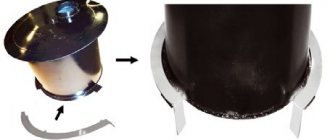Home / Electric boilers
Back
Published: 11/17/2020
Reading time: 4 min
0
675
Electric boilers for heating and hot water supply, due to their full automation, have recently become increasingly popular. Modern factory-produced electric boilers have one very serious drawback - their high cost. Therefore, many home craftsmen are interested in how to make an electric boiler with their own hands.
Market analysts for electric boilers believe that this popularity will only grow in the next decade, especially in connection with the development of household non-traditional solar energy. Which is an alternative source of energy for such boilers.
To implement the idea of a homemade electric boiler, a home craftsman will need to have the skills of a mechanic, welder and electrician or invite such specialists to be his assistants.
- 1 Power calculation 1.1 For a house of 50 square meters
- 1.2 For 100 square meters
Electric boiler
This invention is not new and does not relate to space technology. Be that as it may, the essence is the same - to heat the coolant in the heating system.
We have a house, and there is also a water heating system in the house. But there is no centralized gas supply to install a gas boiler. It remains to decide how to heat this coolant. Alternatively, it could be a homemade electric boiler.
And this is a good option, since such equipment is easy to place and receive heat if there is a power supply.
Positive sides
In addition, there are other positive aspects:
- Easy to install.
- Compact sizes.
- Ergonomics.
- No special permissions are required for installation.
- Environmentally friendly - no harmful emissions into the atmosphere.
- Silence.
- Does not require an additional hood or chimney.
- There is no need for additional fuel storage facilities.
Meanwhile, there is nothing difficult here. Heating elements are placed in a special metal container. The tank is connected to the heating system. The coolant is usually ordinary water.
It is this water that is poured into the system through a metal container. All that remains is to apply electric current to the heating elements.
When exposed to current, the heating blocks become hot and transfer their heat to the water. Hot water from the tank rushes through the pipes into the heating radiators, heating the entire house.
Everything seems simple!
This is the heating circuit in principle.
It can be supplemented with such innovations as:
- system monitoring and control device,
- expansion tank,
- circulation pump.
- automatic water heating regulator.
Flaws
There are disadvantages, how could we live without them? These include:
- Dependence on power supply.
- Scale that forms on heating elements leads to a decrease in their efficiency.
- Dimensions of the expansion tank - the higher the power, the more space there is for placing heating elements.
Main structural elements of boilers
Before making an electric boiler on your own, you should carefully familiarize yourself with its main components:
- heating element;
- The boiler itself;
- Additional equipment for inserting regulators and sensors.
Among them, the greatest importance is given to such a device as a heating element. It is designed to convert standard electrical energy into high-quality thermal energy. In fact, this is a special tubular electric heater. As for the boiler, it can be made from a special pipe made of high-quality metal or some other container
No less important are the various additional structural elements, through which the process of using the boiler can be significantly simplified
Modern models of such equipment are usually sold fully equipped. Among the main elements are:
- Expansion tank.
- High quality filter.
- Circulation pump.
- Safety valve.
Boilers that have all the required structural elements can be made independently; you just need to know and follow a few basic important points.
Varieties
Any electric boiler can be divided according to different criteria:
- Principle of operation;
- Type of instalation;
- Power adjustment.
According to the operating principle
It is quite possible to make a homemade electric boiler for heating of the following types:
- Induction - water is heated using eddy currents in the core of an electromagnetic circuit.
- Electrode - the liquid between two electrodes is heated due to the current passing between them.
- Heating elements - closed-type heating elements, under the influence of current, heat up and transfer heat to the surrounding coolant.
type of instalation
- Wall mounting is a more compact option for placing a heating boiler and, accordingly, low power.
- Floor installation is more voluminous, but, in principle, the dimensions do not matter much, since in this option it is possible to increase the power of the heating equipment.
Power adjustment
Strictly speaking, this concerns the additional capabilities of the equipment that will be used in conjunction with heating boilers. These are various types of automation that are capable of equalizing the temperature of the coolant in the heating circuit. It can be of different designs:
- relay;
- seven-sided;
- on a magnetic starter.
The procedure for assembling a boiler with heating elements with its own rivers
Before you make an electric boiler with your own hands, you should make sure that you have a reliable power supply line. Only equipment with a power of no more than 6 kW can be connected to ordinary networks with a voltage of 220 V and a frequency of 50 Hz. If a more powerful boiler is required, it needs a three-phase wiring and a separate input.
So, we begin assembling a homemade electric heating boiler from a pipe with a cross-section of 159 mm and a wall thickness of 10 mm. This pipe will serve as the boiler body. It will require either a factory-made hemisphere with a cross-section of 159 mm and a thickness of 10 mm, or sheet metal with a thickness of 8 mm or more of a similar section.
The boiler roof, into which the heating elements will subsequently be embedded, can be made from an 8 mm thick channel.
We cut a ¾-inch coupling into the boiler dome. We will screw the drain valve into this coupling. In addition, you will need 2 pipes with a cross-section of 1 inch for inflow and return. The threads on the pipes can be made both internal and external. It all depends on which one you are more comfortable working with.
To relieve excess pressure, you need to prepare a pipe for inserting the bypass channel. You will also need 3 adapters, each of which will have a heating element for the electric boiler screwed into it. Another adapter will be needed for the temperature sensor. In addition, you will need holders for automation.
Please note that it is advisable to cut the threads on the pipes and adapters immediately. Prepared pipes with threads, the same as on heating elements, must be immediately screwed into the adapters
This is necessary so that the threads are not damaged during welding to the arch. To mark the insertion points of the heating elements, the outer diameter of the pipe must be divided into 6 equal sectors according to the radius size. Then we draw three identical sectors strictly at an angle of 120°
Prepared pipes with threads, the same as on heating elements, must be immediately screwed into the adapters. This is necessary so that the threads are not damaged during welding to the arch. To mark the insertion points of the heating elements, the outer diameter of the pipe must be divided into 6 equal sectors according to the radius size. Then we draw three identical sectors strictly at an angle of 120°.
The next step is to start cutting. Having finished with the markings, using a plasma cutter we cut out holes for the pipes for the heating elements. They should be cut only along the outer contour. With all other pipes this is not of fundamental importance.
Let's start welding work. First we intercept the pipes at several points so that they do not lead. Then we check the accuracy of the location, if necessary, lightly tap with a hammer, and then make a continuous seam
It is important that the adapters for heating elements in an electric boiler for heating with your own hands protrude 1 cm above the surface of the boiler roof
Next, you need to make sure that the heating elements fit completely inside the body of the electric boiler. Therefore, after applying a continuous seam, it is necessary to screw the heating elements into the adapters.
Let's start cutting out the vault from the channel. In its center we make a hole for the air valve pipe, after which we weld the pipe itself. We make a hole on the side for the temperature sensor and also weld a pipe under it.
All protrusions, burrs and welding residues must be thoroughly cleaned using a grinder.
Operation of homemade heating systems
All of the above must be supplemented with a rather important clarification. As we found out, electric boilers for heating a home are not greatly affected by surges in mains voltage. But the load on the home network is quite high. Therefore, for the device to operate, you need to worry about high-quality electrical wiring in advance.
In addition, Russian realities are such that power outages are a frequent and unpredictable occurrence. Hence the conclusion - UPS (uninterruptible power supply) must be installed. It will be able to maintain power to the heater for some time. For rural areas, a gas generator is relevant. This way, autonomy will increase, and the heating system will work until the centralized power supply is supplied.
Experienced specialists note that when installing an electric boiler there are a number of technical requirements:
- Before installing the device, the entire heating system needs careful preparation. In particular, flushing and cleaning of the entire heating circuit is necessary;
- the heating system requires the installation of a complex of safety valves with an air vent;
- It is advisable to make all connections of the boiler to the heating system only from metal;
- the temperature regime during installation work should not go beyond +100 to +40 °C;
- for two-story buildings, it is necessary to take into account the fact that only one heating boiler cannot cope with heating the entire building. The best option is to install one heater, with its own group of radiators, on each floor.
DIY electric heating boiler
Operating voltage, volts: 220/380, compressed power, kW: 6, accommodation volume: 360 m3. Warranty term: 10 years.
More details
Model - 180 m² The best option for spacious residential type apartments. Operating voltage, volts: 220/380, compressed power, kW: 9, accommodation volume: 540 m3. Warranty term: 10 years.
More details
Model - 250 m² Independent system for large residential or non-residential premises. Operating voltage, volts: 220/380, compressed power, kW: 12, accommodation volume: 750 m3. Warranty term: 10 years.
More details
Model - 300 m² Heavy-duty scorching unit for small mining and industrial facilities. Operating voltage, volts: 220/380, compressed power, kW: 15, accommodation volume: 900 m3. Warranty term: 10 years.
More details
Model - 360 m² The boiler for burning will have an area of up to 360 square meters. Operating voltage, volts: 220/380, compressed power, kW: 18, accommodation volume: 1080 m3. Warranty term: 10 years.
More details
Model - 420 m² Promislove opalyuvalne obladnannya. Operating voltage, volts: 220/380, compressed power, kW: 21, accommodation volume: 1260 m3. Warranty term: 10 years.
More details
Model - 480 m² Operating voltage, volts: 220/380, compressed power, kW: 24, storage volume: 1440 m3. Warranty term: 10 years.
More details
Model - 540 m² Operating voltage, volts: 220/380, compressed power, kW: 27, storage volume: 1620 m3. Warranty term: 10 years.
More details
Model - 600 m² Operating voltage, volts: 220/380, compressed power, kW: 30, storage volume: 1800 m3. Warranty term: 10 years.
More details
Model - 750 m² Operating voltage, volts: 220/380, compressed power, kW: 36, storage volume: 2250 m3. Warranty term: 10 years.
More details
For buildings with an area of more than 750 m², it is necessary to install two or more electrode boilers “Obriy” of however heavy-duty.
More details
The electric boiler “Obriy” is one of the shortest solutions for a daily combustion system. In order to heat your donkey using an electrode boiler, you do not need to see the area under the boiler, have a stove, or connect to the central gas system. This is especially noticeable in farmhouses and cottages, where there are always problems with scorching.
It should be noted that today electric heating is becoming increasingly popular in Ukraine. Considering the high prices for gas and other types of energy sources, combustion using an additional victorious electric stream is not only more efficient, but also economical.
Where can I buy
You can purchase water heating equipment as quickly as possible at your nearest specialty store. A good option in terms of price-quality ratio is purchasing from the AliExpress online store. Mandatory long waits for parcels from China are a thing of the past, because now many goods are in intermediate warehouses in destination countries: for example, when ordering, you can select the “Delivery from the Russian Federation” option:
| HYUNDAI Instant Electric Water Heater | Electric water heater TINTON LIFE with temperature display | Electric water heater fast heating |
| 2500W floating electric water heater, for bath, swimming pool | Electric heater, instant hot 6500W | Electric water heater, 6500 W, 220 V |
